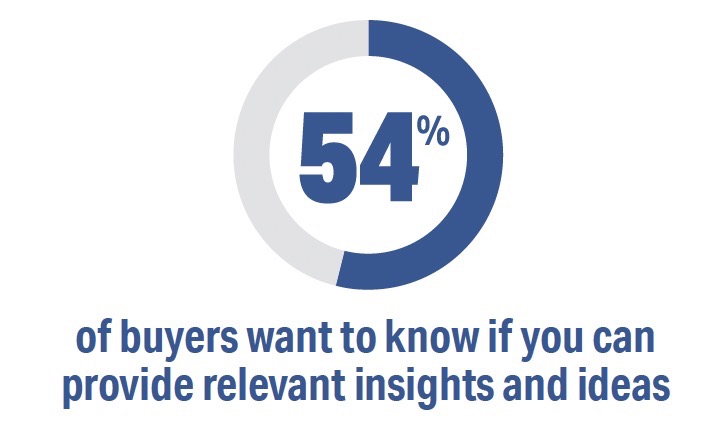Are your prospects ignoring your calls and email messages? That’s not unusual. To attract their attention, consider the situation from their perspective. In a buying situation, most prospects want the answer to a key question: What’s in it for them?
It’s up to you to show how your solution will solve their current problem. And you must build enough trust to convince them that buying from you won’t be a career-ending decision. But before you can deliver on their wants and needs, you have some work to do.
Building Credibility
Results from our Voice of the Buyer survey show that 53% of buyers initially try to solve a business problem on their own. Their second most popular action (46%) is to discuss the issue with a current supplier. Makes sense, doesn’t it? They reach out to a known and trusted advisor.
When these avenues fail to deliver a solution, your opportunity begins. As soon as a buyer begins their online discovery process, you have a chance to be noticed. Whether it’s the need for expert engineering services or a widget to improve the efficiency of their floor cleaning robot, buyers look for links to online research and opinions offered by thought leaders.

You can build credibility and appeal to buyers by listing the kind of information that matters as they evaluate sellers, corporate websites and background reports. When evaluating a provider, buyers pay close attention to:
- Companies with great customer service 36%
- Locally owned businesses 36%
- Product costs on websites 28%
Work with your in-house experts to ensure that your website displays the data points buyers want to see.
Sales Professionalism
Buyers will also be checking out your personal credibility long before they reach out. Your years of overall experience matters to 49% of buyers. Another 46% want to know your industry-specific experience. Keep in mind that for younger buyers, educational background is the second most important factor after years of experience. They’re also far more likely to check your LinkedIn profile than older buyers.
You may not be a fan of using the latest technology to maintain your online presence. However, 23% of younger buyers review videos posted on social media by sales professionals. Their regular online browsing habits should be your reminder to routinely update your profile.
Other aspects of your online persona can impact your credibility. Because everything about everybody appears online today, buyers will take advantage of information they can find. Posts showing your participation in an important cause that most people support, such as feeding the hungry, can position you as a caring person. But 44% of potential buyers will cancel you if they find evidence of your illegal drug use. Use a reputation management service to clean up your image.

How to Reach Out
If you’re fortunate enough to attract the attention of a prospect through your online efforts, such as responding to their comments, it’s time to connect. Your initial outreach might be through a site like LinkedIn, but 35% of buyers prefer email interaction with sales professionals.
This doesn’t mean they never want to see you in person. You’ll need to earn that opportunity, and you can do so by improving on the credibility you built when you first attracted their attention.

What to Say
It might be tempting to open your conversations by mentioning the college you both attended. Keep that angle brief. Focus on what matters to buyers: 52% want you to know how to use your products to solve their problems. If you can provide relevant insights and ideas, you’ll score attention from 54% of buyers.
Remember that when buyers first meet with a seller, they have two objectives: to discuss their goals (23%) and to clarify what they can achieve by using your product (18%). Don’t walk away from your first talk with your prospect until you’ve addressed these topics.
Buyers are looking for great solutions from credible sales reps who they can trust. When you take the time to build your online reputation and focus on solving their problems, they’ll respond to your outreach.




